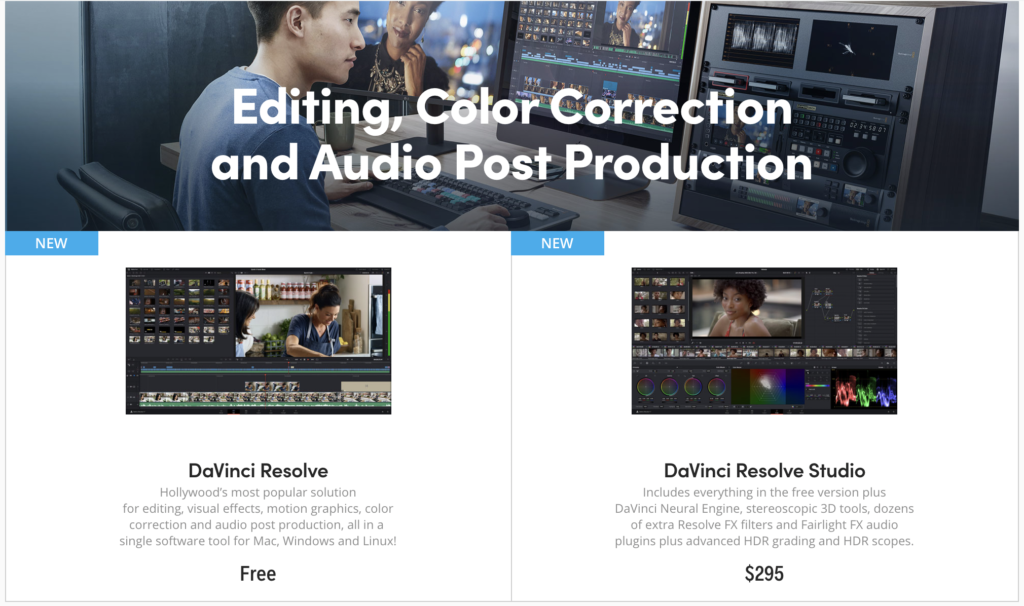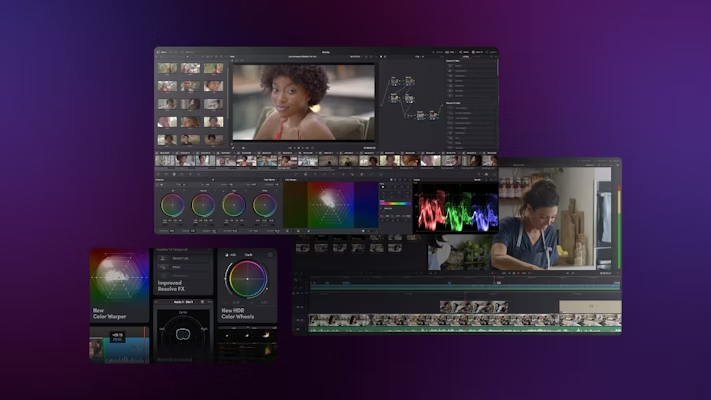DaVinci Resolve’s price has caught the attention of many filmmakers over the last couple of years. DaVinci’s tools have been helping professionals in the industry for a long time. But now their free software, DaVinci Resolve 17, along with their more advanced Studio version, has become even more widely known. So which one should you be using? Let’s compare DaVinci Resolve 17 Free vs Studio.
We’ll look into the price of both versions of the software and the tools included in each. By the end of this article, you should be ready to make an informed decision about which version is right for you.
Summary
Honest Comparison of DaVinci Resolve vs Studio
1. DaVinci Resolve 17 (Free)
The free version of DaVinci Resolve 17, formerly known as DaVinci Resolve Lite, already has a lot to offer in its own right. This version has the capacity to do most of what your average solo content creators will need on a day-to-day basis. DaVinci Resolve 17 is a full post-production suite. You can carry out multi-cam editing, animate your multimedia through keyframing or compositing, and add custom titles and transitions. Version 17 added around 300 new features to the free and studio versions including the HDR pallet, color warper, magic mask, smart reframe, 3d keyer, and multi-user collaboration. However, some of these features are limited to the studio version.
DaVinci generally markets itself to high-end production professionals, which means they can afford to pack a lot of features into the free version. So when you download the free version of DaVinci Resolve, you are not downloading a trial. There is no expiration date or watermark on your export! You will have the tools to start creating professional-grade projects at your fingertips from the get-go. This includes not only editing software but also world-class color grading tools, a compositing program (DaVinci Fusion), and an audio editing program (DaVinci Fairlight).
DaVinci Resolve 17 added the collaboration feature to the free version which is a great benefit to filmmakers. This feature was previously only available with the paid studio version and lets multiple team members, such as colorists and audio mixers, work simultaneously on a project.
Some aspects of DaVinci Resolve’s free version that may fall short include its inability to work with 10-bit footage. This could pose a problem for certain cameras, such as the Panasonic GH5. You are also limited to a 4K UHD (3840×2160) output that could be a dealbreaker for those filmmakers shooting in DCI 4K (4096 x2160) for cinema.
2. DaVinci Resolve Studio 17
Even if you decide to upgrade to DaVinci Resolve Studio, it’s worth noting that the paid version costs only $295. Not only is it extremely affordable when compared with other professional editing software on the market, but it is a one-time payment for a program. You will be able to update DaVinci Resolve Studio for free as new updates are released. It’s also worth noting you even get a free license for DaVinci Studio when you purchase a Blackmagic camera.
When DaVinci already offers so much value in its free version, it’s important to consider whether it is worth investing in Studio. When is it worth the upgrade? If you are working with high-end equipment or post-production workflows, then there are a few features that might make the paid version interesting for you.

What’s Included & More
Performance
One of the key differences with the studio version of DaVinci Resolve 17 is its ability to use GPU acceleration, including utilizing multiple GPUs. The free version can only use some GPU acceleration for playback but for rendering it relies on the CPU. This is especially noticeable when you have a high-end GPU. Performance can improve substantially with popular formats like H.264 and H.265 when using GPU encoding and decoding. The use of the GPU is also critical for other features like GPU accelerated Resolve FX and the DaVinci Neural engine.
Media
As mentioned before, the free version of DaVinci Resolve 17 can import footage with a resolution higher than 4K but can only export up to 4K UHD at 60 frames per second. DaVinci Resolve Studio is capable of exporting up to 32K at 120 frames per second.
The studio version can use 10-bit footage and has an expansive range of formats it can play and export, which is important for professional work.
Noise Removal and Motion Blur
To access the advanced noise removal tools and motion blur or mist effects, it may be worth upgrading to DaVinci Resolve Studio. This can help to create a crisper image, particularly on projects with higher resolutions where extreme attention to image quality is important.
HDR Color Grading and Scopes
High Dynamic Range color grading is supported in DaVinci’s Studio version. The increase in the color data of your image in HDR color grading can add some incredible vibrancy for higher-end projects that need to be Dolby or HDR10+ compliant. The studio version adds HDR scopes that are able to provide detailed information for ST.2084 and HLG images as well as remote grading.
Neural Engine AI
In the DaVinci Resolve Studio 16 update, Neural Engine AI technology was introduced and in version 17 it has been advanced even more. This technology includes a range of tools, including facial recognition, object removal, speed warp re-timing, the new magic mask, object tracking, scene detection, auto-color matching, and more. This could be useful for speeding up your workflow on complex visual effects. This may also be one of DaVinci Studio’s benefits that are not limited to those working in high-end post-production studios.
Improved Resolve FX and Fairlight FX Plugins
Expect to see over 30 more advanced visual and audio plugins in DaVinci Resolve 17 Studio. There are dozens of visual effects including stylized video effects from analog noise to a pencil sketch, lens reflections, dirt removal, analog damage, face refinement, patch replacer, film grain, and de-flickering, and many more.
Stereoscopic 3D Tools
This set of features included only in DaVinci Resolve’s paid version will help you to correct alignment errors and excessive color. This means you can always have better control over your viewer’s eye line, and keep their attention right where you want it.
Additional Features
The studio version of Resolve features many more advanced features like scripting and automation, colorspace transform language, workflow integrations plug-ins, 3D audio, etc. Most of these features are aimed at professional work and if that’s what you are doing you will require the studio version.
As you can see, DaVinci Resolve 17 has some pretty powerful tools in both versions of the program. The paid version, DaVinci Resolve Studio, may appeal mostly to those working on more advanced post-production.
However, there are one or two compelling reasons that could make solo filmmakers or small teams want to invest in it, too. With DaVinci Resolve’s price being so affordable, there’s not much to hold you back from creating stunning content.



























